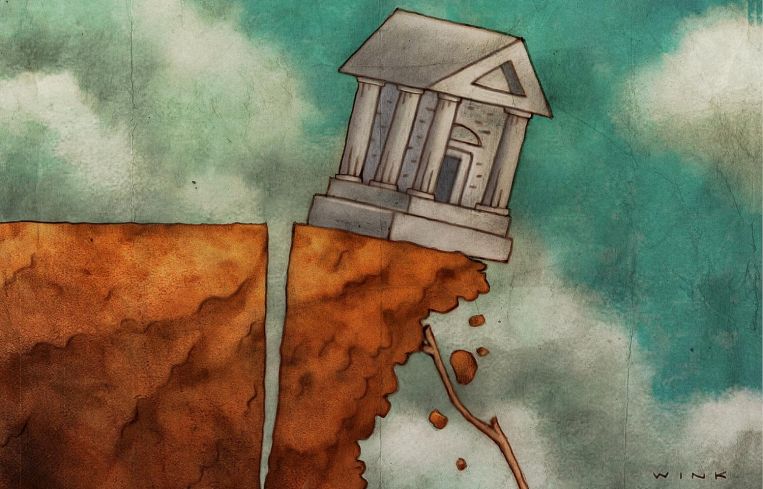A Year Like No Other in Commercial Real Estate Finance
Things looked a lot different at the start of 2022.
By Cathy Cunningham May 2, 2023 8:00 am
reprints
Last year started off with a bang.
Riding high on a record year for most, lenders rang in 2022 with Gatsby-style swagger and champagne.
Entering the second quarter with a spring still in their steps, they popped out loans like hens do eggs, while borrowers were nestled deep in their comfortable nest of cheep — er, cheap — cash.
Little did they know, a fox in the form of the Federal Reserve was fast approaching the hen house, and feathers were about to fly.
It’s hard to pinpoint the exact moment things changed, but many honorees on our list of financial heavyweights say the war in Ukraine was the first domino to fall in February 2022. Right behind it, however, was the Fed’s Jay Powell and his seven consecutive rate hikes — putting to rest an era of (almost) free money and sending shock waves through the market as the hikes were announced in rapid succession.
The lending landscape seemingly shifted with each increase as borrowers struggled to adapt to the new normal, and the borrower-lender relationship quickly became a game of Russian roulette.
“It was undoubtedly a tough year, and deals got harder as the year went on,” BMO Capital Markets’ Paul Vanderslice said. (Editor’s note: When Slice — an industry vet who’s transacted through the hairiest of cycles — says it was tough, then it was tough.)
As rates rose, borrowers balked, property values and cap rates dipped, and some lenders began retrenching, while others held steady.
“We tried very hard to stay in the market, and the first half was extremely busy, and we were ready and still had our dry powder ready for the second half,” PGIM’s Melissa Farrell said.
As that second half rolled on, the choppiness just kept coming. Volatility isn’t exactly bond investors’ favorite, neither is rate instability, and there was plenty of both to go around in the fourth quarter, so the usually efficient commercial mortgage-backed securities market sputtered.
Regional banks, interestingly, are among those that stepped up to fill the void — but, well, more on them next.
Just as some green shoots were maybe, possibly starting to show at the start of 2023, a banking crisis came upon us and commercial real estate was the subject of headlines across the world.
First came Silicon Valley Bank; two days later New York City lost one of its most active regional banks in Signature Bank; then the crisis went global and Credit Suisse was absorbed shortly thereafter.
A brief meltdown ensued. While crypto was initially suspect No.1, commercial real estate was soon called in for questioning. It then found itself in the police lineup, a flashlight’s glare searing its eyes.
Soon, Signature’s rent-regulated loans were alarmingly described as “toxic waste,” in the way that a synthetic collateralized debt obligation may have been described in 2008 (to which the Ghost of Bear Stearns Past chortles and grunts: “Yeah, no. Try harder!”).
Despite regional banks suddenly being viewed as the devil incarnate by everyone and his mother, NYCB gave the middle finger to naysayers and picked up $38.4 billion of Signature’s loans in a quick-
moving fire sale, strengthening its own balance sheet in the process and making investors do a happy dance as its stock skyrocketed.
Still, while regulators and analysts scrutinized banks’ balance sheets with even larger magnifying glasses, suddenly the general public also became aware of a looming tidal wave headed our way in the form of office loans coming due, the words “Class B” rolling off the tongue in grocery stores like “Madonna” did in the ’80s.
But outside of the chatter, the lending landscape was shifting once again. With some — but not all — banks retrenching, an even larger window of opportunity opened up for those with capital to deploy — namely, non-banks and life insurance companies — as other financing sources were sidelined. The CMBS and CLO markets continued to sputter, closing those exits for new originations; mortgage REITs, trading below book value and unable to raise further capital, sat tight; and those alternative lenders reliant on banks for their own funding found their capital had also dried up as warehouse and repo lines closed.
That’s not to say it’s a heyday for those who can lend today, as transaction activity has slowed significantly.
“While a lot of people have pulled back from the market and the supply of loans is less, we need borrowers to borrow and the demand is also less right now,” Apollo’s Scott Weiner said.
As this list was going to press, many of the lenders spoke tentatively but rather optimistically about their pipelines, whether they’re full of CMBS or balance sheet executions. After all, who knows what the next bus to hit us will be?
Oaktree’s Justin Guichard said his firm’s pipeline is “robust” for this year as banks continue to pull back on lending, and his firm sees “a number of attractive opportunities” in the senior loan space.
Farrell said during the past several weeks that PGIM has seen “a pretty big pickup in our pipelines with mostly refinances.”
Ah, refinances. More valuable than the Hope Diamond if you’re a Class B office owner with a loan coming due.
But, just like that diamond, we live in hope. We have had a year like no other, and we’re here to tell the tale. Go forth into the brave new world and ignore the headlines — unless they’re from Commercial Observer.
Cathy Cunningham can be reached at ccunninghman@commercialobserver.com


